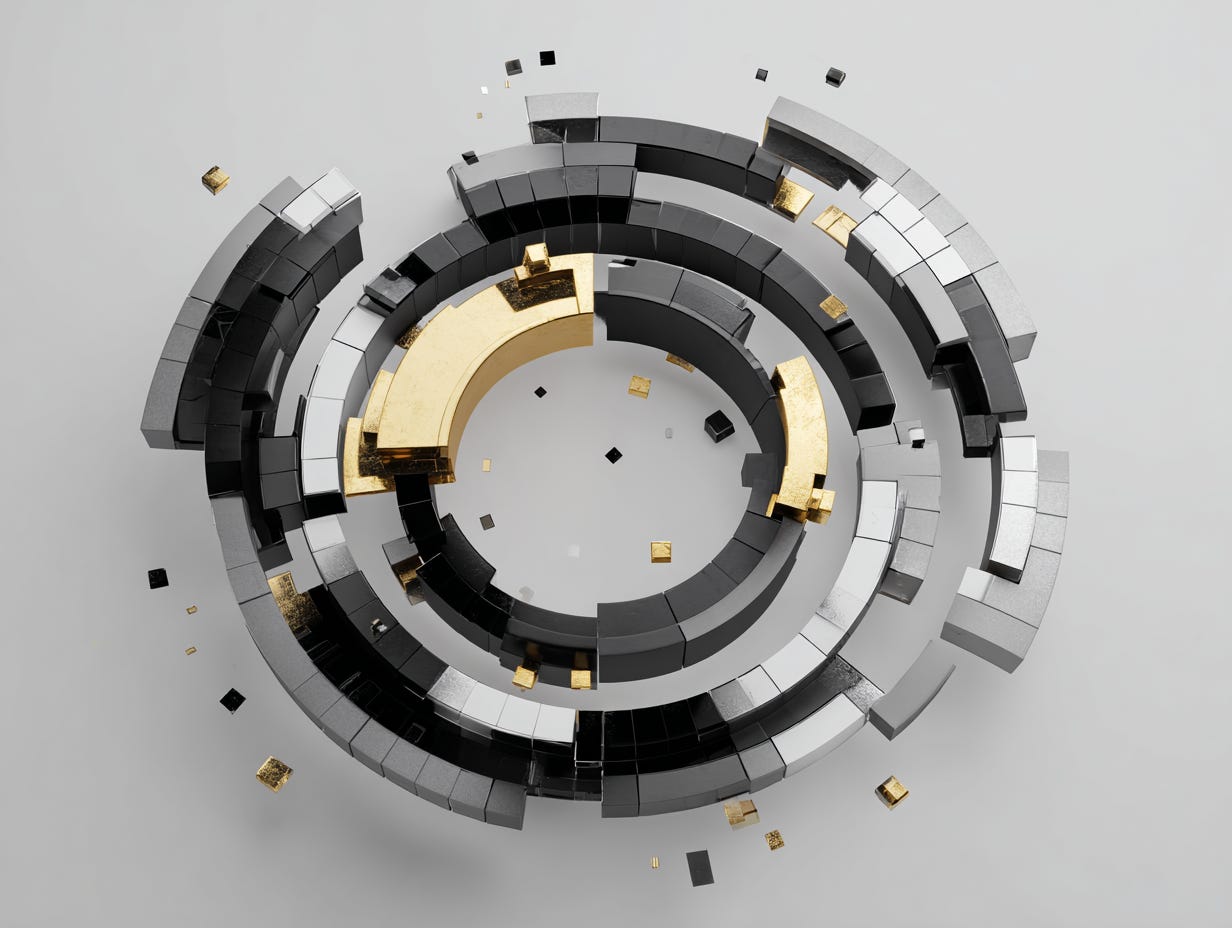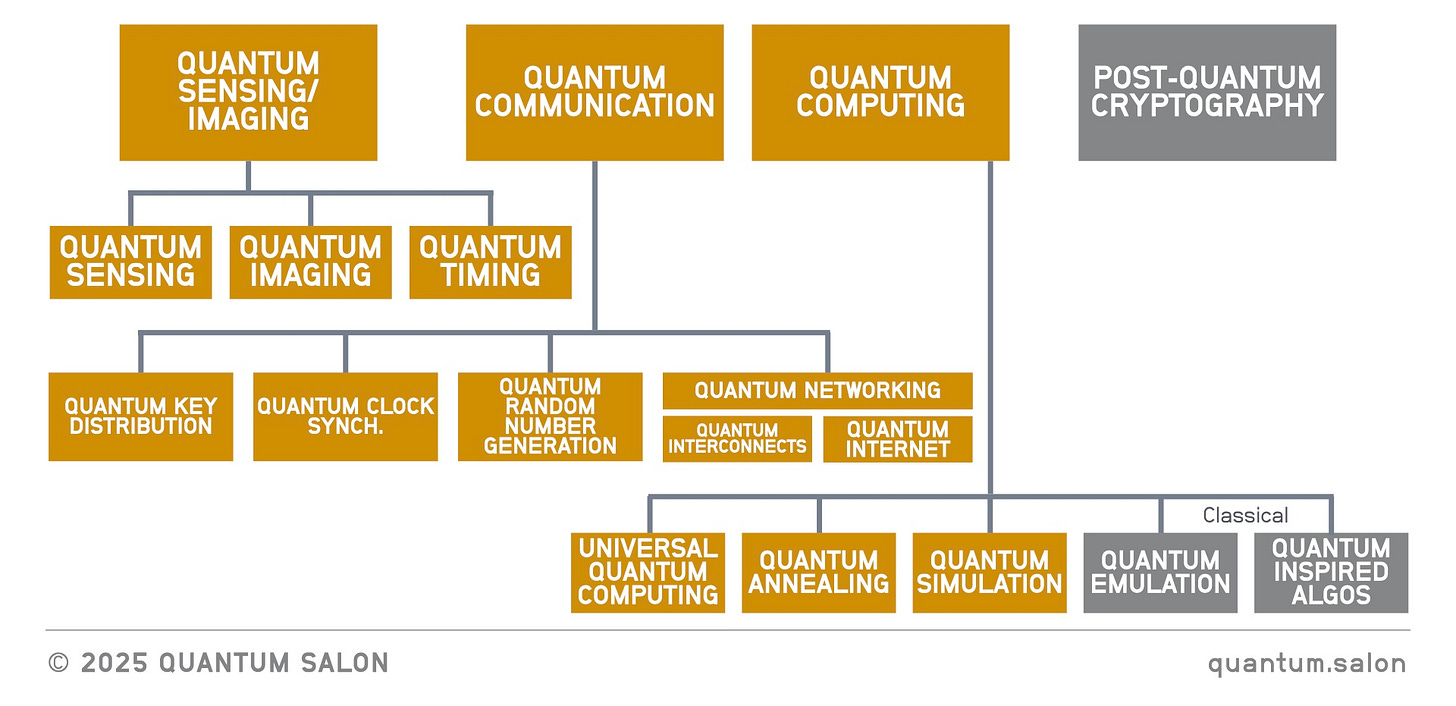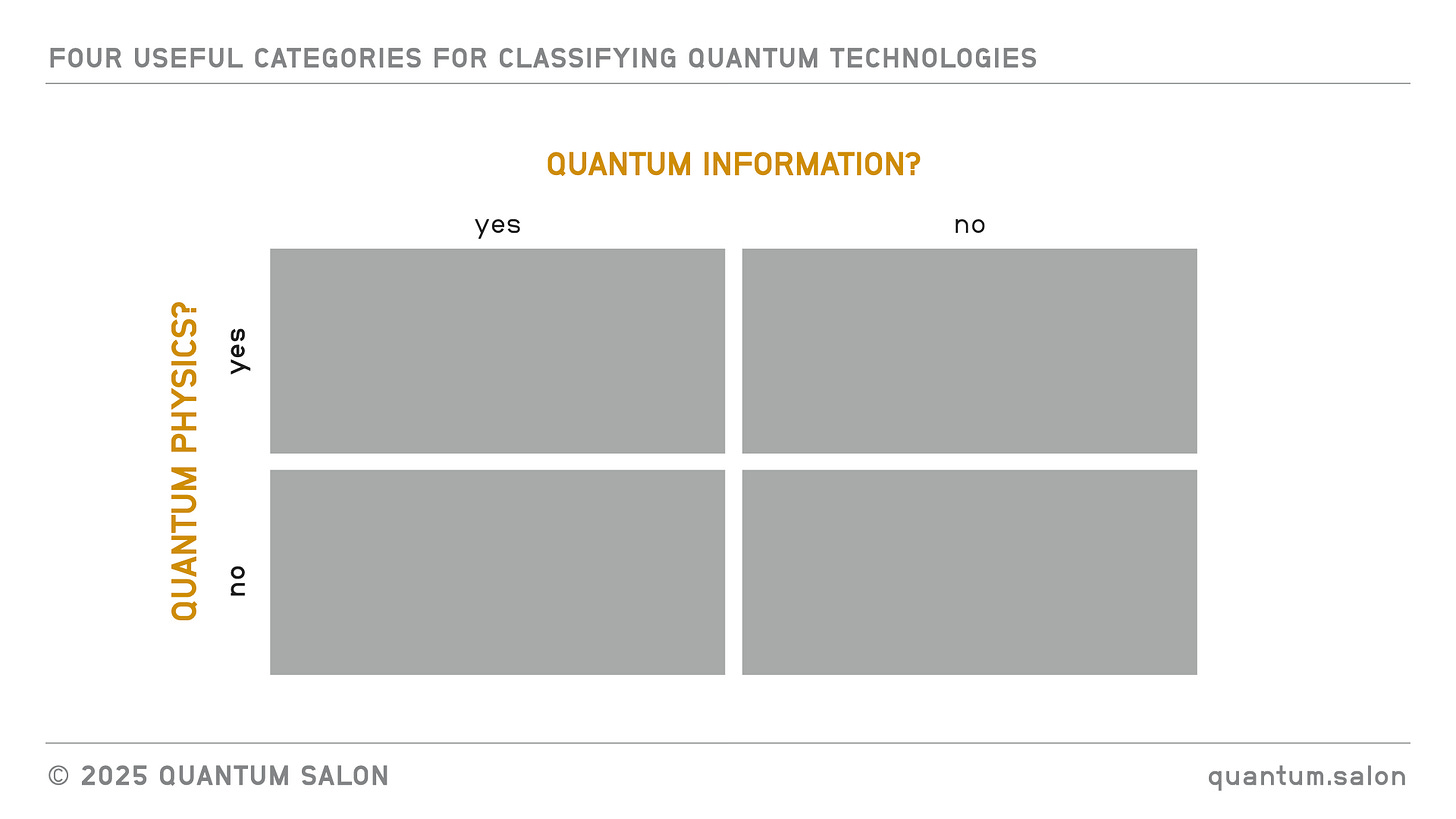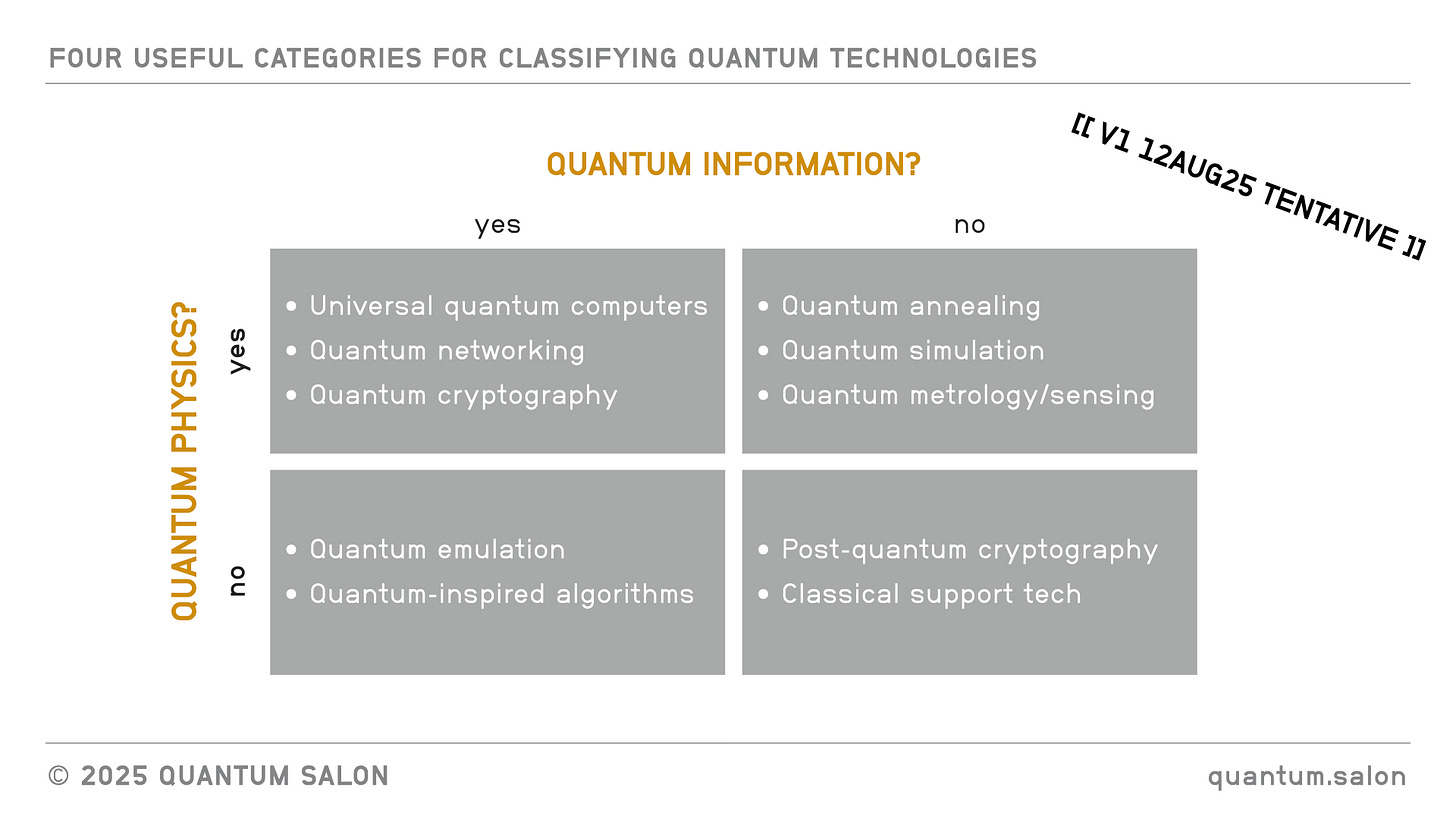Quantum physics vs. quantum information in quantum tech
Towards a decision-making framework for assessing quantum tech companies
Quantum computing isn't the only technology being developed that takes advantage of quantum mechanics. You've probably come across some others as well, like quantum sensing, quantum cryptography, and the quantum internet.
It's useful to have some map of how all of these technologies fit together. I've tried to make one in the past, but I was never entirely satisfied with it. I've seen others do it as well, and I think there are some great infographics out there (see e.g. here), but somehow they don't achieve what I'm trying to get at.
A common approach, which I also initially adopted, was to break things into quantum sensing/imaging, quantum communication, quantum computing, and post-quantum crypto.
My problem with this is that I'm not sure what insight is supposed to be gained from this categorization. It presupposes some kind of lens, but that lens is not explicit. And various things within each category are there with caveats.
I want to try a different approach, which may be more rudimentary, but might be more flexible. The approach is to categorize the technologies along different dimensions (or axes). These axes might take on a binary classification or a spectrum. For each axis, one would also need to identify some correlated factors, to help with gaining new insights and decision making.
The ultimate goal is to have a set of mental models, a decision-making framework of sorts, that is appropriate for your lens (investor, government official, job-seeker, etc.) and for your goals.
A tall order indeed! But let's see how we go.
For simplicity, we can start with two axes. The two I find most natural to start with are: does the technology use quantum physics, and does it need quantum information?
A note on quantum information vs. quantum physics
Quantum information is fundamentally different from classical information. If you’re reading this, you’ve probably heard about classical bits vs. quantum bits (qubits). That discussion is about how the information is represented. There are also differences between how classical and quantum information can be processed, and also how we can read out the result of that information processing.
The representation, processing, and readout of quantum information is fundamentally tied to the way quantum physics works, but it’s possible to represent, process, and read out quantum information using classical physical systems (for example when a student completes a problem set from their quantum information course using pen and paper...as we did in the old days!).
The limitation is that if you’re using classical physical systems (even classical supercomputers) to model quantum information, you run into scaling issues and quickly reach the limits to how complex a quantum information system you can model.
Such limitations aside, we can think of quantum physics and quantum information as separate axes, which gives us four categories to explore.
A note to the experts
If you’re a practitioner and, as you continue reading, you think I’m glossing over some critical nuances which put your technology into a different category below, I really welcome this feedback.
For example, I’m probably glossing over the fact that these days, quantum error correction is being applied to areas outside of traditional quantum information domains (e.g. quantum sensing). This might need to be taken into account.
But I also don’t think the framework will be very useful if everything ends up in the same box. What I’m going for here is something along the lines of that famous quote:
“All models are wrong, some are useful.”
So please give me your feedback, but please frame your feedback in the broader context of making this a more useful framework.
With all those caveats, let’s go!
Quantum physics: yes & Quantum information: yes
Here we have technologies that use quantum physical systems to represent, process, and read out (measure) quantum information. From a practical perspective, we also care about sending that quantum information from one physical location to another, so we need to encode that information in quantum systems that are well-suited for transmission (usually light).
Universal quantum computers are the most well-known example. There are many physical systems currently being developed commercially. These include superconducting circuits, ion traps, neutral atoms, light (photons and quantum modes), and spins.
Quantum networking refers to connecting different quantum computers together. To do that, you need to encode quantum information in a physical system that’s easy to move around (usually a photon or a quantum mode of the electromagnetic field). Over short distances, like in a quantum data centre, this is usually known as quantum interconnects. Over long distances, this is usually known as the quantum internet.
Quantum cryptography uses quantum information protocols to enable secure communication. This includes quantum key distribution (QKD), which allows two parties to generate a shared secret key that's secure against any eavesdropper. Another application in this space is quantum random number generation, which uses quantum physics to generate true randomness for cryptographic systems.
Quantum physics: yes & Quantum information: no
Here we have technologies that use quantum physical systems to perform various tasks better than would be possible otherwise, but that don't require quantum information concepts to be developed. Some readers might object to my categorization here, because practitioners often do use quantum information concepts when working on these technologies (because quantum information is a great unifying language for translating between different quantum physics scenarios), but the point I am making is that they don't need to.
Quantum annealing is a form of computation that is more specialized than universal quantum computation. This is one of those categories where people often use quantum information concepts (D-Wave has qubits, right?). But you don't actually need quantum information concept to make quantum annealers work. What you're really doing is mapping classical optimization problems to quantum physical systems and then letting them evolve, according to the laws of quantum physics, to their lowest energy state.
Quantum simulation gets a little confusing because different communities use different terminology. What I'm talking about here is using one quantum physical system to model another quantum physical system. For example, you might use a trapped ion system to simulate the behaviour of electrons in a high-temperature superconductor. Physicists call this quantum simulation (for the quantum-industry usage of "quantum simulation", refer to quantum emulation in the next section). Again, people often use quantum information concepts to make the mapping between the different systems, but they don't have to. Quantum physics concepts are enough.
Quantum metrology/sensing is another confusing one in terms of terminology. While the terms metrology and sensing are well-defined and distinct, as far as I can tell, folks in the quantum community use the terms quantum metrology and quantum sensing interchangeably for the most part. This category can be broken down into several subcategories. Quantum timing for precise timekeeping, using systems like Cesium fountain clocks. Inertial or field sensors for sensitive measurements of magnetic and electric fields, gravity, rotation and acceleration. Examples include NV-diamond magnetometers and atom-interferometer gravimeters. Quantum imaging for better resolution, sensitivity, or reduced noise, using properties of quantum light like squeezing and entanglement. Quantum radar and LiDAR for remote sensing (quantum radar uses microwaves while quantum LiDAR uses light).
Quantum physics: no & Quantum information: yes
Here we have technologies that deal with quantum information but don't rely on quantum physics.
Quantum emulation (aka quantum simulation in industry) is where you use classical systems to reproduce the computation results of a quantum computer. These classical systems can be regular desktop computers as well as more advanced supercomputers and GPUs (or, as mentioned above, they could just be pen and paper!). Ignoring the technicality that everything in the universe is ultimately quantum in nature, these systems don't use any special properties of quantum physics to perform computation of the quantum information.
Quantum-inspired algorithms are classical algorithms that were developed by people thinking about quantum computing problems, but they run on regular computers. They take ideas from quantum algorithms and adapt them for classical systems. I wasn't sure about whether to put this here or in the next category, but decided to have it here, because by definition, these classical algorithms could not have been developed without quantum information concepts.
Quantum physics: no & Quantum information: no
Here we have all the classical technologies that exist in the quantum ecosystem but don't themselves use quantum physics or process quantum information.
Post-quantum cryptography is the use of classical cryptographic algorithms designed to be secure against attacks from quantum computers.
Classical support technologies includes dilution fridges that cool quantum systems, control electronics that manage quantum devices, orchestration software that coordinates quantum experiments, and the specialized manufacturing tools needed to create superconducting circuits, trap ions, or grow crystals with specific defects for quantum sensing, etc.
Putting it all together, we get the following chart:
How is this useful?
Say that you're an investor and you care about risk. You could make the case that technologies that use quantum physics are riskier to develop than those based on classical physics. You could also make the case that technologies that use quantum information are riskier than those that don't.
Furthermore, the nature of that risk could be different for each axis. You could make the case that for technologies that use quantum physics, progress will be more smooth because the challenges are mostly engineering. On the other hand, for technologies that use quantum information, progress could require some step-function jumps, for example, for new quantum algorithms to be developed. Then again, the discovery of a new quantum algorithm or quantum error correction code could be an inflection point in terms of progress in the field.
Now say you're someone wanting to get a job in the quantum tech industry. Maybe you're coming from academia. Knowing that there are quantum technologies that don't require quantum information expertise is useful. I think many quantum physics PhDs think that quantum computing is their only option, and they feel blocked by the fact that they're not experts in quantum information. This framing helps candidates focused their efforts on subsets of the industry.
Beyond these two axes
There are other axes that are interesting for categorizing quantum technologies. We could for example explore hardware vs. software, analog vs. digital, component vs. system. We can then identify interesting correlated factors.
But we can also go beyond technology. While I don't think we're at the stage in quantum tech where we can abstract away the underlying technology, technology is not the only important thing when assessing a company. So we could also explore axes like business models (B2B vs. B2C) or development time lines (near-term vs. long-term).
Like any categorizations, these will have limitations, but combining multiple axes gives you a richer picture than a single framework can provide. I think what's important is understanding what you're trying to achieve and picking the right lens for your particular context.
A fun immediate thing to do is to take the existing two axes presented here, and start putting companies on the diagram. You can start to do that yourself if you like. If you discover anything interesting, let me know. I will likely do it in an upcoming post too.
What do you think?
Does the categorization above need tweaking? Can you think of any other interesting dimensions to consider? Let me know in the comments!
If you liked this post, feel free to click the 🧡 button here on Substack, or on the LinkedIn or Bluesky post that brought you here. That way, more people can discover it.
At Quantum Salon, we help deep tech teams explain what they’re building and why it matters. If that floats your boat, drop us a line!








Oh yes, quantum semantic rules :D
This is complicated. Everything must be translated into another language with precision. Some academics will always show up and say, “That is wrong because of this or that.”
In Polish, we now have an odd consensus: we cannot publicly say "quantum computer" (komputer kwantowy). Instead, we must say "prototype of quantum computer infrastructure" (prototyp infrastruktury komputera kwantowego). In Polish, it sounds clumsy and overcomplicated.
The European Commission even created the CEN-CENELEC Standardization Roadmap on Quantum Technologies.
Finally, the well-known Polish engineer Dr. Grzegorz Kasprowicz uses the term kwant-ówki — a playful creation from “quant” with the Polish suffix “-ówki,” something like “quantu-let” or more like "quant-things" to describe all quantum technologies.
Where would you put quantum machine learning? It can be analogue or digital and it usually combines both classical and quantum computation.